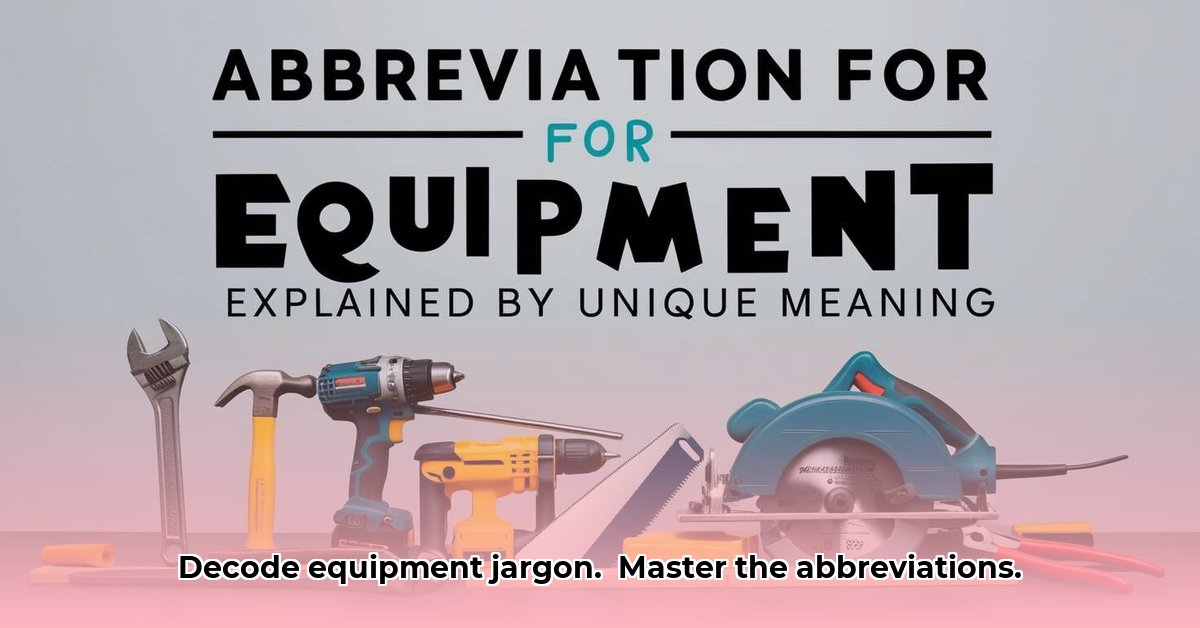Ever been confused by all those cryptic letters and numbers used to describe industrial equipment? In machinery and automation, using the wrong abbreviation can lead to costly mistakes, delays, and even safety risks. This guide teaches you how to understand and use equipment abbreviations correctly, providing tips to ensure clarity.
Understanding Equipment Abbreviation Challenges and Solutions
The world of equipment abbreviations can feel like the Wild West, with inconsistencies across industries and even within the same company. This lack of standardization can lead to confusion and significant errors. This guide helps you navigate this complex landscape and communicate clearly.
Navigating the Complexities of Equipment Shorthand
Abbreviations like “eqpt.” or “equip.” are frequently found in emails and quick notes, particularly in manufacturing or construction. While acceptable in casual contexts, they are unsuitable for formal documents or technical manuals where precision is essential. The context significantly dictates appropriate usage.
Deciphering Industry-Specific Codes
Different industries often have their own sets of secret languages. For example, in industrial automation, terms like PLC (Programmable Logic Controller), HMI (Human-Machine Interface), and SCADA (Supervisory Control and Data Acquisition) are common. However, these abbreviations may be unfamiliar to those outside the field. In healthcare, abbreviations related to medical devices and diagnostic equipment are prevalent. Proper understanding ensures effective interdisciplinary communication.
Implementing Best Practices for Clear Communication
To avoid misunderstandings and ensure clear communication, consider these guiding principles:
-
Know Your Audience: Tailor your language to your audience. Use specialized abbreviations with trained engineers, but opt for full words when communicating with a broader audience like a company’s board of directors.
-
Define Abbreviations Clearly: Explain any uncommon abbreviations the first time they are used. For longer documents, include a glossary. For instance, if using “CMMS,” immediately define it as “Computerized Maintenance Management System.”
-
Maintain Consistency: Stick to your chosen abbreviations throughout your communication. Switching between “eqpt.” and “equipment” can cause confusion.
-
Consider Formality: Use simpler abbreviations in casual conversations but prioritize precision in formal reports, technical documents, and contracts.
-
Adhere to Company Style Guides: Follow your company’s internal style guides for acceptable abbreviations. If none exists, advocate for the creation of one.
Assessing the Risks of Informal Shorthand
Using informal abbreviations carries risks. Consider the potential consequences:
| Risk Factor | Likelihood | Severity | How to Mitigate the Risk |
|---|---|---|---|
| Misunderstanding | Moderate | High | Clearly define all abbreviations and choose formal wording in crucial contexts. |
| Communication Breakdown | Moderate | Medium | Train your team on standard procedures and approved abbreviations. |
| Impact on Professionalism | Low | Low | Be consistent in usage throughout your work. |
| Safety Compromises | Low | Critical | Always use full, unambiguous terms in safety-critical procedures and documentation. |
Developing a Long-Term Communication Plan
Improving abbreviation usage requires a team effort. Here’s how organizations and individuals can work together for better communication:
-
Develop Comprehensive Style Guides: Create internal style guides outlining acceptable abbreviations and their usage, including examples and specific industry terms.
-
Promote Industry Collaboration: Encourage collaboration to establish a set of common abbreviations across industries.
-
Leverage Technology: Use AI-powered tools to identify and suggest correct abbreviations and ensure consistent usage across documents.
-
Provide Training and Education: Incorporate proper abbreviation usage into employee training materials, including quizzes and practical exercises.
By implementing these strategies, organizations can significantly improve communication, reduce errors, and enhance their professional image.
How to Create a Standardized Abbreviation Database for Equipment Across Industries
Have you ever spent hours deciphering cryptic equipment labels? Standardization can help. This section guides you through building a standardized abbreviation database to enhance efficiency and reduce errors.
Key Takeaways:
- Standardizing equipment abbreviations saves time and reduces errors.
- Automated systems are essential for handling large datasets.
- A well-structured database improves communication and collaboration.
Defining Your Database Scope
Start by clarifying your needs. Determine the types of equipment and industries to be included. A narrow scope simplifies the process. For example, focus initially on manufacturing equipment within a specific facility.
Step-by-Step Guide to Building Your Abbreviation System
-
Establish a Clear Naming Convention: Decide on a logical structure for your abbreviations. Base it on existing ISO or industry standards where possible.
-
Create a Centralized Database: Use a database management system (DBMS) like Access or MySQL for scalability. Cloud-based solutions like Google Sheets or Airtable can also be useful for smaller teams.
-
Populate Your Database: Systematically enter equipment data, including full names, acceptable abbreviations, manufacturer details, and industry context.
-
Implement Data Validation: Set up rules to prevent inconsistencies. Use drop-down menus and pre-defined values to minimize errors.
Risk Assessment Matrix
Effective risk management is critical. Consider these factors:
| Risk Category | Potential Risk | Mitigation Strategy |
|---|---|---|
| Data Entry Errors | Incorrect or inconsistent abbreviations. | Data validation rules, double-checking, user training. |
| Data Loss | Accidental deletion or corruption. | Regular backups, version control, secure storage. |
| Lack of Standardization | Inconsistent abbreviation use across departments. | Clear guidelines, mandatory training, enforcement. |
| Security Breaches | Unauthorized access to sensitive equipment data. | Access control, encryption, regular security audits. |
| Version Control Issues | Conflicting updates and outdated information. | Implement version control and track changes. |
Addressing Stakeholder Needs
Involve stakeholders from engineering to procurement to ensure the database meets everyone’s needs and promotes adoption. Conduct surveys and workshops to gather feedback.
Regular Review and Updates
Update your database as equipment changes or new machinery arrives to keep it relevant. Schedule quarterly or annual reviews to ensure accuracy and completeness.
Effective Equipment Abbreviation Strategies Across Diverse Industries
Inconsistent abbreviation usage hinders clear communication. Standardized lists are crucial for minimizing confusion. This section explores effective strategies tailored to different sectors.
Key Takeaways:
- Inconsistent abbreviation usage hinders clear communication and efficient maintenance across industries.
- Standardized abbreviation lists within organizations are crucial for minimizing confusion.
- Effective strategies hinge on context-specific understanding and clear documentation.
The Importance of Abbreviations and the Need for Standardization
Abbreviations save time in documentation, but inconsistency creates problems. Effective strategies aim to prevent misunderstandings. The complexity of equipment influences abbreviation usage, highlighting the need for tailored approaches.
Developing and Implementing Effective Strategies
Consider these steps:
-
Create a Centralized Glossary: Develop a comprehensive, accessible list of abbreviations. Make it available online and in print.
-
Establish Clear Guidelines: Define rules for creating new abbreviations, including length restrictions and naming conventions.
-
Consider Industry-Specifics: Adapt strategies to each sector’s unique language. For example, aviation uses different terms than manufacturing.
-
Provide Training and Education: Conduct regular sessions to keep employees updated on codes. Use real-world examples and case studies.
-
Regularly Review and Update: Update your glossary to reflect technological changes.
-
Integrate Technology: Incorporate abbreviations into CMMS/EAM systems to maximize efficiency.
Risk Management
Ignoring inconsistencies leads to mistakes and safety hazards. Mitigate risks with company-wide standards and comprehensive training.
| Risk Factor | Impact | Mitigation Strategy |
|---|---|---|
| Inconsistent Abbreviations | Miscommunication, Errors, Safety Hazards | Establish company-wide standards, provide comprehensive training |
| Lack of Centralized Glossary | Confusion, Inefficiency | Develop and maintain an up-to-date glossary. |
| Outdated Abbreviations | Misinterpretations | Regularly review and update. |
| Regional Variations | Misunderstandings in global teams | Document regional variations and provide translations |
Clear communication streamlines operations, reduces errors, and fosters trust within organizations.
Equipment Abbreviation Usage in Regulated Environments: Best Practices and Safety Considerations
In regulated industrial settings, understanding abbreviations is crucial. Misinterpretations can lead to equipment failure, safety hazards, or legal issues. This section guides you through safe and effective abbreviation usage.
Key Takeaways:
- Consistent abbreviation usage minimizes miscommunication and improves safety.
- Standardized glossaries and training programs are crucial.
- Understanding industry-specific abbreviations is vital.
Standardizing Abbreviations for Safety
Inconsistent abbreviation usage leads to confusion and errors. Standardization prevents misinterpretations, leading to safer, efficient operations.
Creating a Custom Glossary
-
Identify All Abbreviations: Review documentation and communications.
-
Define Each Abbreviation: Ensure clarity and consistency. Provide context and examples.
-
Create a Central Glossary: Make it accessible to all employees. Store it on a shared network drive or intranet.
-
Regularly Review and Update: Keep it current and accurate. Assign a specific person or team to manage the glossary.
Providing Training and Education
Regular training is critical. Consider interactive sessions, refresher courses
- Bento Box Trays Streamline Restaurant Meal Presentation and Transport - December 13, 2025
- Plastic Bento Boxes Face Scrutiny Over Sustainability Impacts - December 11, 2025
- Bento Tray Revolutionizes Organized Meal Transport and Presentation - December 10, 2025










